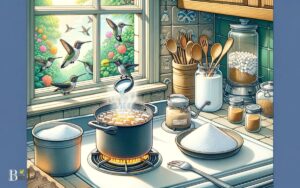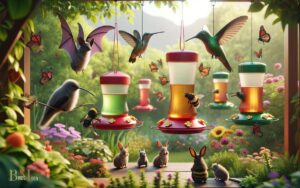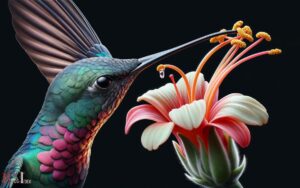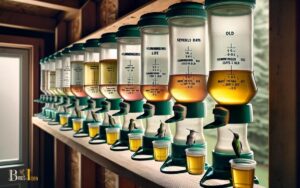How to Make Hummingbird Food For Winter? 4 Easy Steps!
Creating homemade hummingbird food for winter is simple: mix one part white sugar with four parts water, boil the mixture to eliminate bacteria and allow it to cool before filling the feeder.
Hummingbirds require a high-energy diet, especially in winter when natural food sources are scarce. Homemade nectar, made from sugar and water, mimics the sweetness of flower nectar.
Quick Steps:
Ensure the survival and health of wintering hummingbirds by providing homemade nectar with this easy-to-follow recipe.
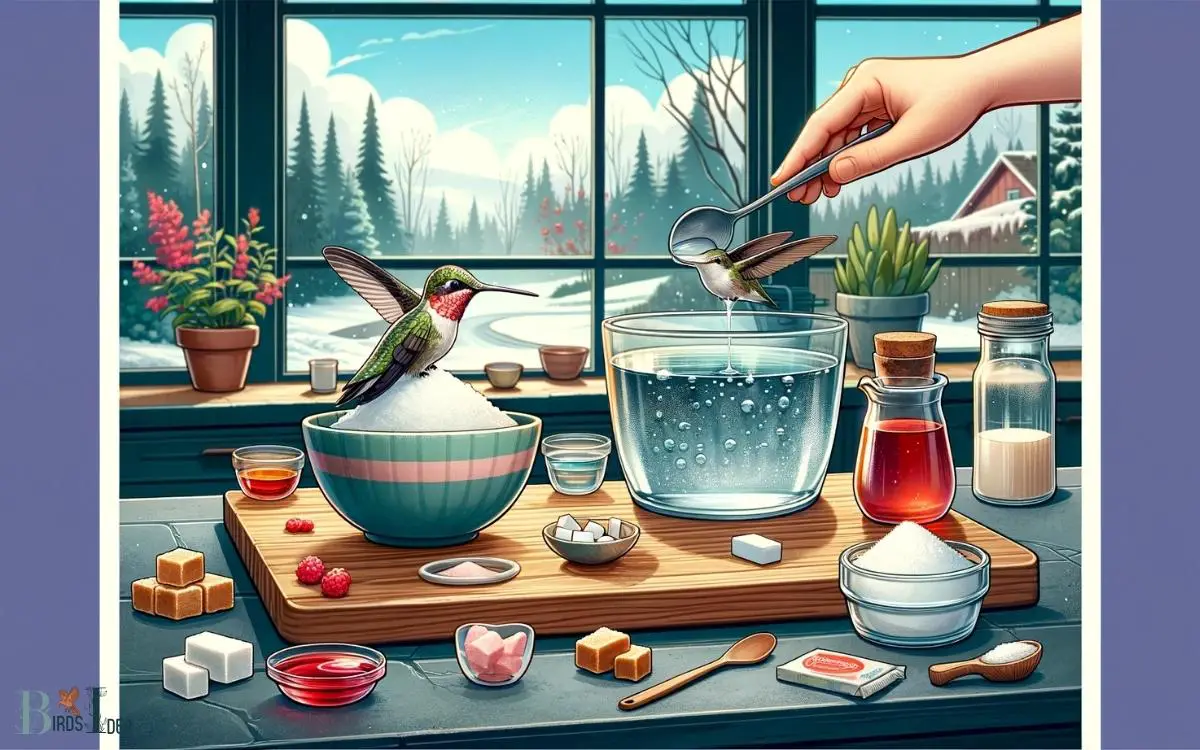
Key Takeaway
Understanding Hummingbird Nutritional Needs
The nutritional needs of hummingbirds are essential for their survival during the winter months.
As the temperature drops, their natural food sources become scarce, making it crucial for us to understand and meet their dietary requirements.
Hummingbirds primarily feed on flower nectar, which provides the necessary sugars for energy.
They require proteins and essential nutrients found in insects and spiders. During winter, when these food sources are limited, providing a reliable substitute becomes imperative.
Understanding the delicate balance of carbohydrates, proteins, and fats that hummingbirds need is crucial in ensuring their well-being during the colder months.
Choosing the right hummingbird feeder and preparing the appropriate food can make a significant difference in supporting these magnificent creatures through the winter season.
Step 1: Choosing the Right Hummingbird Feeder
Selecting an appropriate hummingbird feeder is essential for providing a suitable food source during the winter months.
When choosing the right feeder for hummingbirds, consider the following:
- Feeder Design: Opt for a feeder with perches to allow hummingbirds to rest while feeding. Look for a feeder with bee guards to prevent bees from accessing the nectar.
- Materials: Choose feeders made of durable materials such as glass or plastic, as these are easier to clean and maintain, ensuring the health of the hummingbirds.
- Feeder Capacity: Select a feeder size that matches the number of hummingbirds in your area. This ensures an adequate supply of food without wastage.
Step 2: Selecting the Best Sugar for Hummingbird Food
An essential consideration when providing a suitable food source for hummingbirds during the winter months is ensuring the selection of the best sugar for hummingbird food.
The ideal choice is white, granulated sugar as it closely resembles the nectar found in flowers that hummingbirds naturally feed on.
It is important to avoid using brown sugar, organic, honey, or artificial sweeteners, as these can be harmful to the hummingbirds.
The table below provides a comparison of different sugar types to guide your selection.
| Sugar Type | Pros | Cons |
|---|---|---|
| White Granulated | Closest resemblance to nectar | Lacks additional nutrients |
| Brown | Contains some nutrients | May contain additives |
| Organic | Less processed, some nutrients | Expensive |
| Honey | Natural sweetener | Can promote fungal growth |
Step 3: Mixing the Perfect Hummingbird Nectar
When it comes to mixing the perfect hummingbird nectar, the sugar water ratio is crucial. Finding the right balance of sugar to water ensures that the nectar is both attractive to hummingbirds and provides them with the necessary energy.
Some may wonder about the safety of adding food coloring to the nectar, an aspect that also warrants consideration.
Sugar Water Ratio
Achieving the ideal sugar water ratio is crucial for creating the perfect hummingbird nectar. To ensure that your sugar water mixture provides the necessary energy for hummingbirds during the winter months, follow these key steps:
- Use a ratio of 1 part white granulated sugar to 4 parts water to replicate the natural nectar found in flowers.
- Boil the water first to remove impurities and then add the sugar, stirring until completely dissolved.
- Let the mixture cool to room temperature before filling your hummingbird feeder.
Step 4: Filling and Placing Your Hummingbird Feeder
Filling and placing your hummingbird feeder requires careful consideration of location and the proper mixture of nectar.
To ensure the well-being of the hummingbirds that visit your feeder, follow these essential steps:
- Choose a semi-shaded location to protect the nectar from spoiling too quickly and to provide the birds with some protection from the elements.
- Hang the feeder at a height that allows for easy access and cleaning, typically around 5-10 feet off the ground.
- Keep the feeder away from potential predators, such as cats, by placing it in a location that is not easily accessible to them.
Maintenance and Cleaning of Hummingbird Feeders
Ensuring the cleanliness and regular maintenance of your hummingbird feeder is vital to providing a safe and healthy environment for the visiting birds.
Clean the feeder with a solution of one-part white vinegar to four parts water at least once a week, and more frequently in hot weather.
Use a small brush to scrub the feeding ports and any other nooks and crannies. Rinse the feeder thoroughly with clean water before refilling it with fresh nectar.
When refilling, always discard any remaining old nectar and clean the bottle thoroughly. Inspect the feeder for any signs of wear and tear, such as cracks or damage, and replace any worn parts as needed.
By maintaining a clean and well-maintained feeder, you will help ensure the health and well-being of the hummingbirds that visit your garden.
Can I Make Hummingbird Food for Winter Without Boiling?
Yes, you can make hummingbird food without boiling. Simply mix one part white granulated sugar with four parts water until the sugar dissolves. However, it’s important to note that boiling the water is recommended to ensure that any impurities are removed. Nonetheless, this alternative method can be used if needed. Enjoy feeding these delightful flying creatures during winter!
Monitoring Hummingbird Activity in Winter
How frequently should one monitor hummingbird activity in winter to ensure the continued health and well-being of the visiting birds?
- Daily Monitoring: Check the feeders daily to ensure they are not frozen and that there is enough food for the hummingbirds to sustain themselves during the cold winter months.
- Observation: Spend some time observing the behaviors of the visiting hummingbirds, noting any signs of distress or unusual behavior that may indicate health issues.
- Record Keeping: Keep a log of the number of hummingbirds visiting the feeders and the amount of food consumed, as this can provide valuable insight into their winter activity and health.
Conclusion
Making hummingbird food for winter requires understanding their nutritional needs, choosing the right feeder, selecting the best sugar, mixing the perfect nectar, filling and placing the feeder, and maintaining and cleaning it.
Monitoring hummingbird activity in winter is important to ensure their well-being. Interestingly, hummingbirds have the highest metabolism of all birds, with a heart rate of up to 1,260 beats per minute, highlighting the importance of providing them with the right nutrition.


